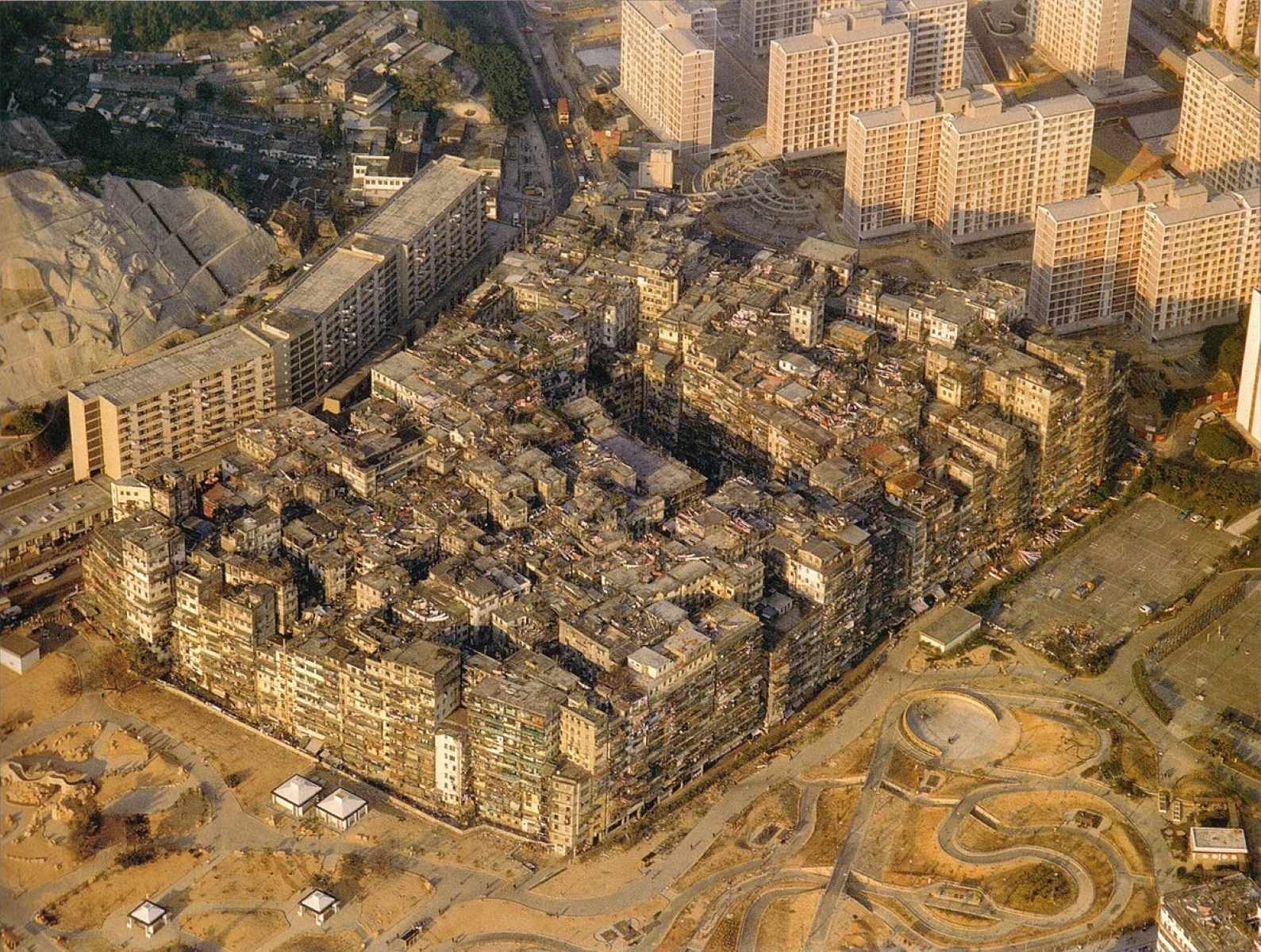
What was Kowloon Walled City? Imagine a place so densely packed that sunlight barely reached the ground. Kowloon Walled City was a unique urban enclave in Hong Kong, known for its chaotic architecture and lawless reputation. Originally a small fort during the Song dynasty, it transformed into a bustling, unregulated community by the mid-20th century. With around 50,000 residents crammed into just 6.4 acres, it became one of the most densely populated areas on Earth. Despite its notoriety for crime and poor living conditions, the city had a strong sense of community and resilience. Its demolition in 1993 marked the end of an era, but its legacy lives on.
Key Takeaways:
- Kowloon Walled City, once a small fort, transformed into a densely populated slum with unique architecture and a strong community spirit, reflecting human resilience and adaptability in the face of adversity.
- Despite its lawless reputation, Kowloon Walled City had a rich cultural significance, close-knit community, and lasting legacy, inspiring artists and filmmakers with its unique story of human resilience.
Origins and Early History
Kowloon Walled City has a fascinating history that dates back centuries. Let's dive into its origins and early transformations.
-
Origins as a Small Fort: Initially, Kowloon Walled City started as a small Chinese outpost for the salt trade during the Song dynasty (960-1279 AD). This fortification was crucial for controlling the salt trade, a significant economic activity at the time.
-
Transformation into a Military Outpost: During the Qing dynasty (1644-1912), the fort was converted into a militarized outpost to check British influence in the region. In 1847, a defensive wall was added, giving it the name Kowloon Walled City.
-
British Influence and Symbolic Control: After the Opium Wars, the British forced China to cede Hong Kong but allowed China to retain symbolic control of Kowloon Fort. This unique arrangement would later impact the city's fate significantly.
World War II and Population Boom
The city's population and structure changed dramatically during and after World War II.
-
Japanese Occupation During WWII: The Japanese army seized Kowloon Fort during World War II and dismantled the defensive wall to use the materials for expanding a nearby airport. This action set the stage for future changes.
-
Post-War Population Growth: By 1947, approximately 2,000 squatters lived in the area. Refugees fleeing the Chinese Civil War were attracted by the lack of laws and regulations, leading to a significant population increase.
-
British Hands-Off Policy: In 1948, the British attempted to drive out the squatters but failed. They adopted a "hands-off" policy, allowing the city to grow unchecked due to its remote location and lack of jurisdiction.
Unregulated Growth and Architecture
Kowloon Walled City's architecture and population density were unlike any other place on Earth.
-
Unregulated Construction Boom: With no building regulations, residents built homes using whatever materials they could find. This led to a spontaneous mega-structure of makeshift alleyways, plumbing, electrical wires, and mismatched apartments.
-
Population Density: At its peak, Kowloon Walled City had an estimated population of 50,000 people, with a density of approximately 1,255,000 inhabitants per square kilometer (3,250,000/sq mi) in 1987, making it the most densely populated spot in the world.
-
Unique Architecture: The city's architecture was characterized by haphazardly built high-rise buildings. Residents constructed homes as the population grew, creating a forest of mismatched apartments stacked on top of one another.
-
High-Rise Slum: This high-rise slum was a marvel of improvisation. Residents used whatever materials they could find, creating a labyrinthine structure that was both functional and precarious.
Crime and Community Life
Despite its reputation for lawlessness, Kowloon Walled City had a strong sense of community.
-
Triads as De Facto Governments: The city became a haven for criminal activity, with opium dens and brothels common. Triad gangs like "Sun Yee On" and "14k" became the enclave's de facto governments, ruling with an iron fist but also organizing community services.
-
Community and Social Structure: Despite its lawless reputation, the city was home to a tightly knit community. Families formed close bonds, with wives doing housekeeping and grandmothers caring for children.
-
Yamen as Social Centre: The yamen in the heart of the city was a major social center. Residents could talk, have tea, watch television, and take classes such as calligraphy. Religious meetings and temple activities also took place here.
-
Community Initiatives: The Triads organized community initiatives like a volunteer fire department, rubbish disposal, and pensioner schemes, helping maintain some order in the chaotic environment.
Demolition and Legacy
The end of Kowloon Walled City marked the beginning of a new chapter for its residents and the site itself.
-
Demolition Plans: In the 1980s, both the British and Chinese governments wanted to demolish the city due to poor sanitary conditions. They offered $350 million in compensation to residents and businesses, leading to the eventual demolition in 1993.
-
Forced Evictions: Some residents were not satisfied with the compensation and had to be forcibly evicted. Many looked back on their time in the Walled City as a happier period despite its challenges.
-
Demolition and Legacy: After residents found new homes, the city was demolished, and the site turned into Kowloon Walled City Park. The park preserves artifacts from the Walled City, including remnants of the South Gate and the old administrative office.
-
Preservation Efforts: Preservation efforts were made to document the city's history and architecture. The park now serves as a museum and a reminder of the city's unique past.
Cultural and Historical Significance
Kowloon Walled City holds a special place in history and culture, reflecting the complex dynamics of Hong Kong and China.
-
Cultural Significance: Despite its dark reputation, the city had rich cultural significance. Residents formed close-knit families, and community gatherings were common. Rooftops served as gathering places, and the yamen was a central hub for social activities.
-
Historical Context: The city's history is deeply intertwined with the broader historical context of Hong Kong and China. From its origins as a small fort to its transformation into a densely populated slum, it reflects the complex political and social dynamics of the region.
-
Photographic Record: Canadian photographer Greg Girard and British publisher Ian Lambot documented the city extensively between 1987 and 1992. Their photographs provide a poignant record of life in one of the world's most unique urban environments.
-
Architectural Analysis: Architect Hyunjun Yoo analyzed the city's structure, highlighting its unique features. The architecture was characterized by haphazard construction, with buildings stacked on top of one another without a proper design or urban plan.
-
Community Memories: Many residents have fond memories of their time in the Walled City. Despite the challenges and hardships, the community spirit and resilience of the residents are often cited as remarkable aspects of life there.
-
Economic Impact: The lack of regulations and oversight led to a thriving black market, with various illicit activities contributing to the city's economy. However, many residents lived in poverty and squalor.
-
Health Concerns: Poor sanitary conditions and lack of health regulations led to numerous health concerns. Diseases such as tuberculosis and cholera were prevalent, and residents often suffered from poor living conditions.
-
Social Services: Despite the challenges, social services existed within the Walled City. The Old People's Centre provided care for seniors, and religious institutions like Fuk Tak and Tin Hau temples offered support to residents.
-
Cultural Exchange: The city was a melting pot of cultures. Residents from various backgrounds lived together, contributing to a diverse cultural landscape. This diversity was reflected in the architecture, with buildings showing a mix of traditional and makeshift designs.
-
Media Representation: The Walled City has been featured in various media, including films and documentaries. Its unique architecture and lawless reputation have made it a fascinating subject for storytellers and photographers alike.
-
Historical Significance: The city holds significant historical importance. It reflects the complex political and social dynamics of Hong Kong and China, particularly during the 20th century. The transformation from a small fort to a densely populated slum is a testament to human resilience and adaptability.
-
Architectural Innovation: The architecture was innovative in its own right. Residents used whatever materials they could find to build their homes, creating a unique and functional structure that was both precarious and resilient.
-
Community Spirit: Despite its lawless reputation, the city had a strong community spirit. Residents looked out for one another, forming close-knit families and community groups. This spirit was crucial in helping residents endure the hardships of living in such a challenging environment.
-
Economic Activities: The city was home to various economic activities, including food production and trade. However, these activities were often unregulated, contributing to the city's reputation for lawlessness and poor living conditions.
-
Demolition Process: The demolition was a complex process. Residents were offered compensation, but many were not satisfied with the terms. The demolition itself marked the end of an era and the beginning of a new chapter for Hong Kong.
-
Architectural Documentation: Architects and historians have documented the city's architecture extensively. The unique structure, characterized by haphazard construction and high-rise buildings, has been studied and analyzed by experts.
-
Cultural Legacy: Kowloon Walled City has left a lasting cultural legacy. Its unique architecture and community spirit have inspired artists, writers, and filmmakers. The city's story serves as a testament to human resilience and adaptability in the face of adversity.
-
Historical Record: The city's history is well-documented through various sources, including photographs, articles, and historical records. This documentation provides a comprehensive understanding of life in one of the world's most unique urban environments.
-
Economic Impact: The lack of regulations and oversight led to a thriving black market, with various illicit activities contributing to the city's economy. However, many residents lived in poverty and squalor.
-
Health Concerns: Poor sanitary conditions and lack of health regulations led to numerous health concerns. Diseases such as tuberculosis and cholera were prevalent, and residents often suffered from poor living conditions.
The Legacy of Kowloon Walled City
Kowloon Walled City was a place like no other. From its origins as a small fort to its transformation into a densely populated urban jungle, it defied norms and regulations. This unique enclave, with its haphazard architecture and tight-knit community, showcased human resilience and adaptability. Despite its reputation for lawlessness and crime, the residents formed a vibrant, self-sustaining community. The demolition in 1993 marked the end of an era, but the legacy lives on through Kowloon Walled City Park and countless stories. This remarkable place continues to fascinate and inspire, reminding us of the complexities of urban life and the strength of community spirit. Kowloon Walled City wasn't just a slum; it was a testament to human ingenuity and the will to survive against all odds. Its story remains a powerful chapter in the history of Hong Kong and urban development.
Frequently Asked Questions
Was this page helpful?
Our commitment to delivering trustworthy and engaging content is at the heart of what we do. Each fact on our site is contributed by real users like you, bringing a wealth of diverse insights and information. To ensure the highest standards of accuracy and reliability, our dedicated editors meticulously review each submission. This process guarantees that the facts we share are not only fascinating but also credible. Trust in our commitment to quality and authenticity as you explore and learn with us.


